Abstract
Objectives The aim of this study is to evaluate the sources of anxiety and stress among dental students when returning back to training in dental colleges in the era of COVID-19, with the evaluation of a secure condition for training and practicing without the risk of contamination.
Materials and Methods A questionnaire was edited in English and distributed to the dental students through the official site of Al-Farabi Private College/Jeddah/KSA. The questionnaire was assessed with different parameters: general information of respondents, anxiety and stress during dental training, importance criteria to be applied by dental college, and exploring the uses and benefits of e-learning.
Results There were 315 respondents who participated in the study. About 85% participants feel anxiety and stress to return to the dental college. Theses-fearing expressed as high level for 63% compared with 2% before COVID-19. Almost 75% had supported the procedures to be implemented to ensure the safety of the students. About 43% of respondents agreed to continue e-learning in theoretical part only, 1% for clinical part only, and 47% in both. Finally, 67% of respondents preferred the use of alternative methods of learning (Phantom Laboratory) or any simulated teaching aids.
Conclusions A revision of infection control management, improving the working environment, and learning how to deal with patients in purpose to protect everyone are mandatory to alleviate student anxiety to return to training in dental colleges.
Keywords: COVID-19, Air-borne droplets aerosols, anxiety and stress, dental students, severe acute respiratory syndrome
Introduction
The quickly expanding number of cases and proof of human-to-human viral transmission drove the World Health Organization (WHO) to pronounce a general well-being crisis of universal worry over worldwide pneumonia on January 30, 2020. This pneumonia has begun in Wuhan (China) and distinguished as a novel coronavirus (2019-nCOV), the seventh group of coronaviruses. 1 This serious, intense respiratory condition was alluded as novel coronavirus (2019-nCo) and coronavirus disease 2019 (COVID-19). This virus is similar to the group of infections of severe acute respiratory syndrome (SARS) but more infectious than SARS-CoV and Middle East respiratory disorder coronavirus (MERS-CoV). 2 3 Saudi Arabia recorded the first confirmed case of COVID-19 on March 2, 2020. 4
Clinical manifestations of the patient tainted from COVID-19 are fever, hack, myalgia, or weakness, with anomalous chest CT and less normally diarrhea, hemoptysis, headache, or sputum production. 5 COVID-19 spreads when someone inhales infectious aerosols that an infected person releases through talk, breath, and sneezes, or touches a contaminated surface and then touches his mouth, nose, or eyes. Infection with COVID-19 may cause disease that manifests from asymptomatic infection, mild-to-severe pneumonia leading to death. 6 7
Studies have proposed that COVID-19 might be airborne droplets aerosols. 8 The basic transmission courses of COVID-19 incorporate direct transmission (hack, wheeze, and bead inward breath transmission) and contact transmission (contact with oral, nasal, and eye mucous layers). 8 9 10 The transmission of COVID-19 isn't constrained to the respiratory tract. Eye exposure may give a successful path to the infection to enter the body. The asymptomatic brooding time frame for people contaminated with COVID-19 has been accounted from 1 to 14 days, and it was affirmed that those without symptoms can spread the infection. 11 12
Dental patients and medical’s health care professionals can be exposed to pathogenic microorganisms that present in oral cavity and respiratory tract. Dental consideration settings constantly convey the danger of COVID-19 disease because of the explicitness of its strategies, which includes direct contact with patients, and regular introduction to salivation, blood, other body liquids, and the treatment of sharp instruments. The pathogenic microorganisms can be transmitted in dental settings through inward breath of airborne microorganisms that can stay suspended all around. 13 In addition to the infected patient’s cough and breathing when using dental devices such as high-speed dental handpiece and work with running water, a large amount of aerosol and droplets mixed with the patient’s saliva or even blood will be generated. Particles of droplets and aerosols are small enough to stay airborne for an extended period before they settle on environmental surfaces or enter the respiratory tract. 13 At the point when a dentist works on a patient, a lot of vaporized droplets from the patient's salivation or even blood will be produced before they choose natural surfaces or enter the respiratory tract. 14
New instructions from WHO are recommended for dealing with COVID-19 in dental clinic. 15 16 Most countries have taken precautionary measures to confront the pandemic, such as, suspension of attendance at schools, universities, and workplaces; and the postponement of unnecessary treatments including elective dental treatments. Because of this routine, dental treatments were discontinued during the period of dealing with COVID-19 and were limited to emergency cases.
Stress is a normal psychological and physical reaction to the demands of life and with the gradual return to normal life, it is normal for everyone to feel anxious and have their own fears. Everyone reacts differently to difficult situations, and it’s normal to feel stress and worry during this pandemic crisis of COVID-19. The sources of anxiety and stress for dentists during this crisis are raised, and may in part be related to the high risk of exposure to COVID-19 during the usual work of dentists. It would be beneficial to evaluate the anxiety, and stress among dental students when they return back to training in dental college in the era of COVID-19.
Materials and Methods
This study was approved by the Research Ethics Committee in Al-Farabi Private College/Jeddah. A total of 500 dental students were invited to participate, and 315 responded, resulting in a response rate of 63%. An electronic Google questionnaire containing 14 questions based on the information given by WHO for COVID-19 was formulated. The questionnaire was edited in English and Arabic, and distributed to the dental students (see the questionnaire in Supplementary 1 ) through the official site of the college. The questionnaire was divided into multiple sections to assess different parameters: general information of respondents, assessment of anxiety and stress during dental training, evaluation of important criteria to be applied by dental college to provide maximum protection of infection during dental training. The final section of the questionnaire included specific questions about the effectiveness and student’s satisfaction regarding e-learning education in the theoretical and practical aspects in dental colleges.
Undergraduate dental education in Saudi Arabia is a 7-year program. The first year is a general preparatory year that is common to all health colleges, followed by 5 years of dental school. The final year is a 12-month internship program.
All undergraduate dental students from 4 to 7 years level were eligible to participate. Study participants were recruited from among the dental students of Al-Farabi Private College/Jeddah who are in direct contact with the patients and this was considered the main criterion of selection.
Results
There were 315 respondents in the study. The respondents comprised 149 (47%) male and 166 (53%) female. A total of 88% (278) respondents were Saudi and 12% (37) were non-Saudi.
The distribution of respondents according to the academic levels was as following: intern (23%), level 12 (26%), level 11 (22%), level 10 (13%), and level 8 and 9 (16%).
A large number of participants (85%) feel anxiety and stress when thinking of returning back to training in dental college to complete their study. These fears were as high as 63% compared with 2% pre-COVID-19 ( Fig. 1 ).
Fig. 1.
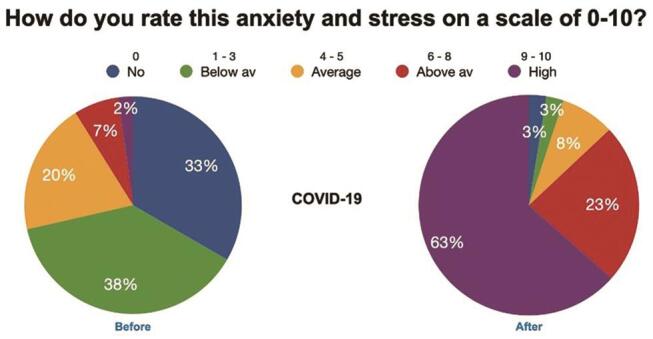
Rate of anxiety and stress.
The anxiety and stress for (78%) of respondents were related to the thinking of the inability of dental college to apply the standard preventions and protection measurements recommended by WHO.
The rate of fear to get infected with diseases during dental training was up to (73%) of respondents after COVID-19 pandemic compared with the period before COVID-19 (5%) ( Fig. 2 ).
Fig. 2.

Rate of fear.
A sizable proportion (58%) of the respondents reported that they have high level of fear to expose to the outside community after a long period of quarantine ( Fig. 3 ).
Fig. 3.
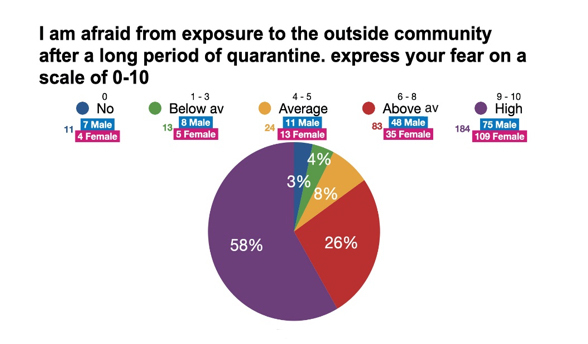
Fear rate of exposure to outside community.
Furthermore, the majority of respondents (almost 75%) had supported all the proposed procedures to be implemented by colleges in the clinical training and theoretical session to ensure the safety of the students ( Fig. 4 ).
Fig. 4.
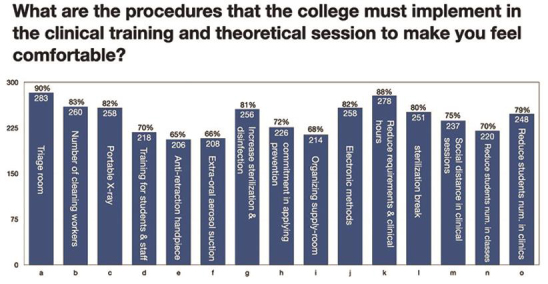
Procedures must be implemented by colleges.
A total of 75% respondents had high level of fear if the college won’t apply the parameters of prevention and protection recommended for COVID-19 ( Fig. 5 ).
Fig. 5.
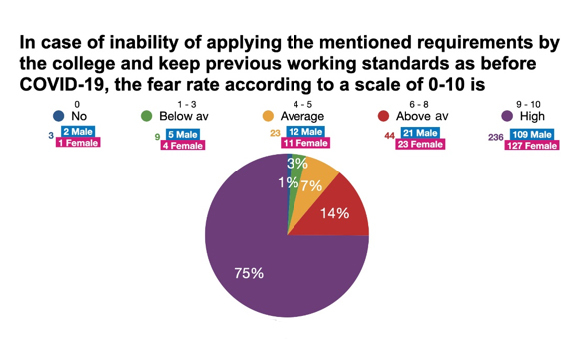
Rate of fear if requirements not applied.
The persistence of this fear was related to lack of confidence of patient commitment of infection control guidelines for (92%) of respondents, while for (85%) of respondents it was related to lack of confidence in the college’s ability to provide all the safety requirements ( Fig. 6 ).
Fig. 6.
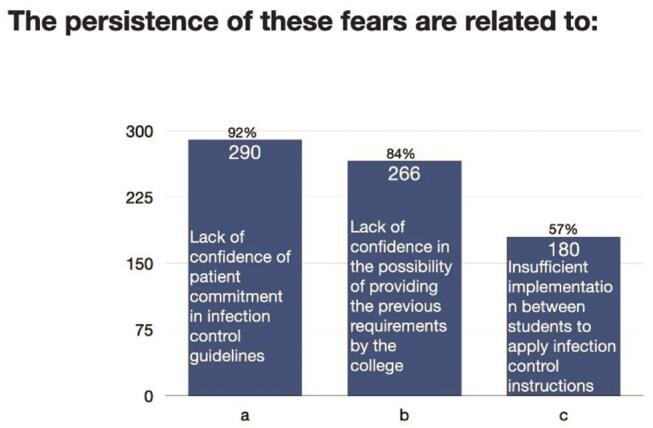
Reasons for persistence of fear.
Also, when exploring the uses and benefits of e-distance learning, ~43% of respondents agreed to continue in theoretical part only, 1% for were for clinical part only, 47% were for both, and 9% disagreed to continue these methods of learning ( Fig. 7 ).
Fig. 7.

E-learning.
Furthermore for 57% of respondents, e-learning fulfills the theoretical requirements, and for 31% e-learning fulfills the clinical requirements only ( Fig. 8 ).
Fig. 8.
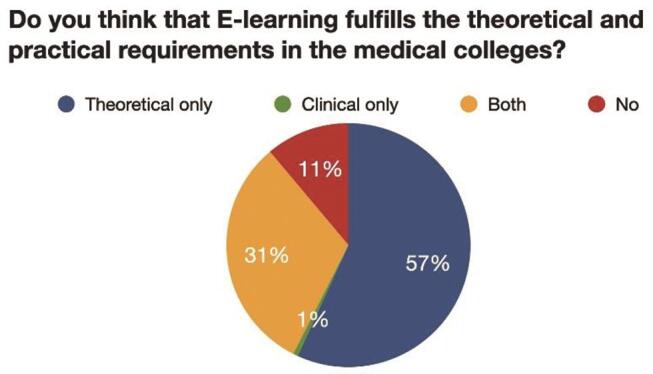
In which part E-learning fulfills requirements.
Finally, 67% of respondents preferred the use of alternative methods of learning (Phantom Laboratory) or any simulated teaching aids instead of direct contact with the patient in dental colleges ( Fig. 9 ).
Fig. 9.

Alternative education.
Discussion
The COVID-19 pandemic has shocked the whole planet, forcing the entire world population to reconsider all the habit of relationship and mutual contacts to avoid the continuous spread of the epidemic. 17
Multiple factors can predispose and provoke fear in the daily practice of dental students, 18 19 one of these factors is the infection transmission. Most dental procedures generate aerosols, which are considered the main way of spreading COVID-19 and lead to anxiety and stress in dental students to return to training in dental college during COVID-19 crisis. The most of the surveyed participants in this study were young and had a lack of experience, that’s why the most significant causes of fear among them were related to dental practice.
This study was conducted at Al-Farabi Private College in Jeddah City, Saudi Arabia, during July of 2020. All undergraduate dental students, who had clinical training from level 8 to intern were eligible to participate.
The questionnaire was completed by 315 dental students. Our findings indicate that 85% of respondents experience immense anxiety and stress (63%) related to their return to clinical training. Regarding gender, no significant difference in fear between female and male was noticed.
Comparing the fear of getting infected with diseases during the clinical training, the percentage was raised from 5% before COVID-19 to 74% after COVID-19. This augmentation could be attributed to the pressure exerted on students to finish their clinical requirements with unsafe conditions of prevention and protection regarding infection control measurements.
There is a consensus by the respondents that the dental college must implement certain procedures in the clinical training and theoretical session respecting the guidelines by WHO for dental practice. It is necessary to university clinics or structures of the National Health Service to adopt measurements and precautions that minimize the spread of the virus. On the contrary, these procedures may require huge costs for equipment and necessary devices.
The current COVID-19 pandemic is affecting health care institutions in ways that may disrupt the training of future health care professionals. Training continues to play an important role during the COVID-19 pandemic, but due to the current circumstances, the e-distance learning is the only option for teaching during COVID-19 crisis. The result of our study indicates that 43% of the students agreed to continue e-learning for the theoretical part, 1% for the clinical part, and 47% for both. While 31% of participants found that e-learning fulfills the theoretical and practical requirements in the medical colleges.
Surprisingly, 67% of students agreed to use clinical education alternatives (Phantom Laboratory) or any simulated teaching aids instead of direct contact with the patient. The increasing level of fear to facing the COVID-19 crisis justify the responses of the students to replacing the direct contact with the patients to simulated or alternative ways of teaching.
Conclusions and Recommendations
This study concluded that following instructions recommended for dealing with COVID-19 in dental clinics (the guidelines of WHO) is imperative to alleviate student anxiety to return back to training in dental colleges in addition to implementing effective measures to deal with student’s anxiety and their psychological state.
To the knowledge of the authors, the present study is considered to be the first study to evaluate anxiety and stress among dental students to return to training in dental colleges during the COVID-19 era.
However, in the limitations of the study that was done in a single dental institute in Al-Farabi Private College/Jeddah, we recommend the conduction of extensive studies from other different dental colleges (cross-sectional study) to elaborate a final protocol which helps facing medical international crisis.
We are in a very difficult and confusing time. The undergraduate dental students in Al-Farabi Private College in Jeddah showed important level of fear. The fear of COVID-19 has a huge impact on dental students to return back to training in dental college, which indicates the need to revise the training programs in dental education to adapt to any medical crisis. This requires a revision of infection control procedures, improvement the working environment and learning how to deal with patient in purpose to protect everyone.
This COVID-19 crisis will produce changes in dentistry that will lead us to break the cycle of teaching (learning and training). In the meantime, we must acknowledge that the College of Dentistry unfortunately will not be able to resume regular teaching and learning activities as before COVID-19. What is certain is that significant steps must be taken before to restart and resume learning and training in dental colleges.
Authorities in dental colleges and medical education should be more involved in the process of an agreement of protocols and procedures must be elaborated to be implemented before dental students can return to the training.
Dental professionals were always vulnerable to infections, many long before the novel coronavirus. So, they need to proceed with utmost caution and treat everyone as a potential risk without causing more anxiety. This will require many necessary changes. We need to assure our staff, students, and our patients that we’re committed to maintaining the highest standard of infection control, sanitization, and accessibility to personal protective equipment.
Funding Statement
Funding None.
Footnotes
Conflict of Interest None declared.
Supplementary Material
References
- 1.Zhou P, Yang X L, Wang X G.A pneumonia outbreak associated with a new coronavirus of probable bat origin Nature 2020579(7798)270–273. [DOI] [PMC free article] [PubMed] [Google Scholar]
- 2.Kharma M Y, Alalwani M S, Amer M F, Tarakji B, Aws G. Assessment of the awareness level of dental students toward Middle East Respiratory Syndrome-coronavirus. J Int Soc Prev Community Dent. 2015;5(03):163–169. doi: 10.4103/2231-0762.159951. [DOI] [PMC free article] [PubMed] [Google Scholar]
- 3.Wrapp D, Wang N, Corbett K S.Cryo-EM structure of the 2019-nCoV spike in the prefusion conformation Science 2020367(6483)1260–1263. [DOI] [PMC free article] [PubMed] [Google Scholar]
- 4.Available at: https://www.moh.gov.sa/en/Ministry/MediaCenter/News/Pages/News-2020-03-02-002.aspx. Accessed Aug 25, 2020
- 5.
- 6.Huang C, Wang Y, Li X.Clinical features of patients infected with 2019 novel coronavirus in Wuhan, China Lancet 2020395(10223)497–506. [DOI] [PMC free article] [PubMed] [Google Scholar]
- 7.Wang D, Hu B, Hu C et al. Clinical characteristics of 138 hospitalized patients with 2019 novel coronavirus-infected pneumonia in Wuhan, China. JAMA. 2020;323(11):1061–1069. doi: 10.1001/jama.2020.1585. [DOI] [PMC free article] [PubMed] [Google Scholar]
- 8.Wax R S, Christian M D. Practical recommendations for critical care and anesthesiology teams caring for novel coronavirus (2019-nCoV) patients. Can J Anaesth. 2020;67(05):568–576. doi: 10.1007/s12630-020-01591-x. [DOI] [PMC free article] [PubMed] [Google Scholar]
- 9.Latalska M, Mackiewicz J. The implication of ocular manifestation of COVID-19 for medical staff and patients - systematic review. Ann Agric Environ Med. 2020;27(02):165–170. doi: 10.26444/aaem/122790. [DOI] [PubMed] [Google Scholar]
- 10.Lu C W, Liu X F, Jia Z F.2019-nCoV transmission through the ocular surface must not be ignored Lancet 2020395(10224)e39. [DOI] [PMC free article] [PubMed] [Google Scholar]
- 11.https://in.dental-tribune.com/news/how-to-use-ultraviolet-light-uvc-to-fight-covid-19-effectively-in-dental-clinics-dr-ajay-bajaj/. Accessed Aug 25, 2020
- 12.Backer J A, Klinkenberg D, Wallinga J. Incubation period of 2019 novel coronavirus (2019-nCoV) infections among travellers from Wuhan, China, 20-28 January 2020. Euro Surveill. 2020;25(05):2.000062E6. doi: 10.2807/1560-7917.ES.2020.25.5.2000062. [DOI] [PMC free article] [PubMed] [Google Scholar]
- 13.kharma MY, Alalwani MS, Koussa B et al. Up to which extent dentists are ready to confront COVID 19 – what they should know? (Updating Knowledge) IOSR J Dental Medical Sci (IOSR-JDMS) 2020;19(03):50–54. [Google Scholar]
- 14.Patini R. How to face the post-SARS-CoV-2 outbreak era in private dental practice: Current evidence for avoiding cross-infections. J Int Soc Prev Community Dent. 2020;10:237–239. doi: 10.4103/jispcd.JISPCD_202_20. [DOI] [PMC free article] [PubMed] [Google Scholar]
- 15.Peng X, Xu X, Li Y, Cheng L, Zhou X, Ren B. Transmission routes of 2019-nCoV and controls in dental practice. Int J Oral Sci. 2020;12(01):9. doi: 10.1038/s41368-020-0075-9. [DOI] [PMC free article] [PubMed] [Google Scholar]
- 16.Krishnan V, Scapellato S et al. Coping with COVID-19 - the life changing pandemic. J World Fed Orthod. 2020;9(02):45–46. doi: 10.1016/j.ejwf.2020.05.003. [DOI] [PMC free article] [PubMed] [Google Scholar]
- 17.Peditto M, Scapellato S, Marcianò A, Costa P, Oteri G. Dentistry during the COVID-19 epidemic: An Italian workflow for the management of dental practice. Int J Environ Res Public Health 2020;17(9):3325 doi:10.3390/ijerph17093325 [DOI] [PMC free article] [PubMed]
- 18.Basudan S, Binanzan N, Alhassan A. Depression, anxiety and stress in dental students. Int J Med Educ. 2017;8:179–186. doi: 10.5116/ijme.5910.b961. [DOI] [PMC free article] [PubMed] [Google Scholar]
- 19.Carter AE, Carter G, Boschen M et al. Pathways of fear and anxiety in dentistry: a review. World J Clin Cases. 2014;2(11):642–653. doi: 10.12998/wjcc.v2.i11.642. [DOI] [PMC free article] [PubMed] [Google Scholar]
Associated Data
This section collects any data citations, data availability statements, or supplementary materials included in this article.


